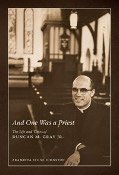The Episcopal Diocese of Mississippi is the only diocese in the country to have a third-generation bishop. Bishop Duncan M. Gray presided over the diocese from 1943 to 1966; his son, Bishop Duncan Gray Jr. (to whom I will refer below as "Bishop Gray," for clarity's sake), served from 1974 to 1993; and his son, Bishop Duncan Gray III, was consecrated bishop in 2003 and still leads the diocese to this day. The "family of bishops" has a strong record on racial reconciliation, but the second Bishop Gray had a particularly unique historical opportunity to make himself vulnerable and to make those around him brave.
Advocacy, as Bishop Gray personified it, wasn't just about speaking. It was about giving voice to the silenced, and giving context to the voices of the silencing. "And One Was a Priest: The Life and Times of Duncan M. Gray Jr. Jackson," by Araminta Stone Johnston (University Press of Mississippi, 2011, $40), quotes a letter that Bishop Gray received late in life:
"I met you 35 years ago, and the circumstances had a real impact on my life. Do you remember the Religious Emphasis Week at Mississippi State in February 1956? I was a senior at State and you were talking to a group of us ... when a newspaper reporter in the audience asked you about the Bible and segregation. Your reply, that the Bible and segregation were incompatible, was on the front page of the Jackson newspapers the next day. ... What you and the others did ... gave me the courage to express my true feelings and I thank you for it, albeit belatedly."
When the Episcopal Church honors Bishop Gray in stained glass, I suspect it will depict him standing on top of the 17-foot Confederate monument at the University of Mississippi the night of the segregation riots on Sept. 30, 1962, calling on the angry white crowd to show restraint—restraint that he had been asking the white community in Oxford to show for months as James Meredith worked to integrate Mississippi's flagship university.
Bishop Gray was attacked and pulled off the monument, but survived. The environment was comparable to that of a lynch mob, and the angry crowd would go on to kill two observers before being dispersed by federal troops. For his part, Bishop Gray would endure years of death threats and police harassment. It is on this part of Bishop Gray's life—as a priest advocating civil rights during the 1960s—that Johnston's book focuses. (She dedicates only a single chapter to his 19-year tenure as bishop.)
As Bishop Gray called for restraint, Gov. Ross Barnett called for violence. Several weeks before the riots, on Sept. 13, Barnett rejected the rule of law and called on white Mississippians to reject desegregation not only by all "lawful and constitutional means," but also explicitly by "every (other) means." While the Civil Rights Movement was divided between advocates who supported strict nonviolence and advocates who felt that violence in self-defense could be justified, the governor of Mississippi openly advocated aggressive violence—in an environment where unprosecuted lynchings, such as the 1955 murder of Emmett Till—had
long been accepted as a fact of life, in an environment where he knew his words would carry weight. It was in this environment that Bishop Gray decided to make
his stand.
An advocate assumes the role of a shepherd, usually without knowing whether he or she has any sheep. Barnett and Bishop Gray were both shepherds—but while Barnett used his platform to build his own political power base at the probable expense of the people around him, Bishop Gray used his platform to build up the people around him at the probable expense of his life. That he survived is remarkable. That he went on to lead the Episcopal Church in Mississippi, and ultimately consecrate Mississippi's first female priest, is even more remarkable. That he did all of this and remains a kind and humble man is, perhaps, miraculous.
I met Bishop Gray Jr. in 2004 when he guest-presided over the small afternoon Spanish-language service at St. Andrew's Cathedral. He was nervous about his Spanish pronunciation; Johnston's book points out that he knew little Spanish when he had been assigned to a Cuban mission trip during the 1950s, but had worked hard to improve his knowledge of the language.
At 79 years old and a legend in the church, but not a legend in his own mind, he was worried that he might not do justice to the liturgical Spanish Rite II—that he would sound too much like an English speaker. I saw him preach to a room full of Latino Episcopalians who, despite being for the most part too young to remember the Mississippi Civil Rights Movement firsthand, were well aware of who he was and what he had accomplished. They were grateful to have him in the room, and they understood that to be an Episcopalian in Mississippi at this point in history still means standing with Bishop Gray.
Araminta Stone Johnston signs and reads from "And One Was a Priest: The Life and Times of Duncan M. Gray Jr." starting at 5 p.m. May 10 at Lemuria Books (202 Banner Hall, 4465 Interstate 55 N., 601-366-7619).



Comments
Use the comment form below to begin a discussion about this content.
comments powered by Disqus